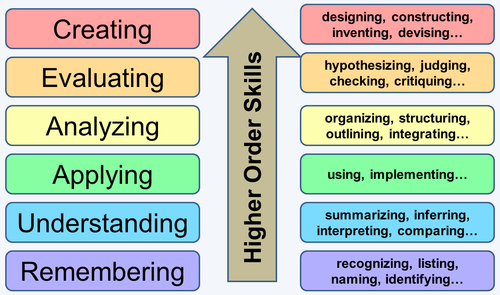Bloom’s taxonomy is a classification of thinking, moving though six layers of complexity frequently described as a staircase from lower to higher ordered thinking. Initially proposed in 1954 and revised in 2001 it offers a framework to consider teaching and learning. This site does not attempt a dissection of pedagogy merely offers the insight that Bloom’s Taxonomy is possibly the most succinct way of explaining why, ”Your presentation sucks because science.” Presentations, as routinely constructed and delivered, do not work because they fail to offer or guide the recipient through any progression across Bloom’s taxonomy.
Benjamin S Bloom thought about thinking. In 1948, with a group of educators, he described the three domains of thinking; cognitive, affective and psychomotor. Within each domain it was proposed that students would move from knowledge through comprehension and application to analysis, synthesis and ultimately evaluation. The taxonomy was revised from noun forms to verb forms in 2001 describing remembering, understanding, applying, analysing, evaluating and creating of the learning. Essentially, this is the description of the learning journey that the educator, in a relationship with the learner, will facilitate.

Acquisition of knowledge is not the aim of education, it is merely the foundation. Effective presentations need to actively involve the learner in progress across Bloom’s taxonomy. Simply delivering facts is not teaching. Hearing facts is not learning.
Pedagogy is the study of method and practice of teaching. “PowerPoint” learning of data entered into a presentation and read out to passive learners fails at every level to facilitate the learning journey described by the taxonomy. The nature of delivery and importantly reception of the majority of presentations aims at the very base of the classification, delivery of information. The psychological evidence is clear that retention of data delivered in this manner is minimal, even when learners are actively engaged. It is thus almost impossible to progress. The continual bombardment with information actively inhibits the opportunity to understand, apply analyse or evaluate lest the “learner” fall behind. The belief underpinning this approach to education is simplistic and anachronistic. Transmission of knowledge is not learning. Reading out PowerPoint is not teaching. Listening to PowerPoint being read out is not learning. This is The Matrix.